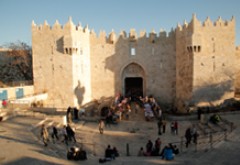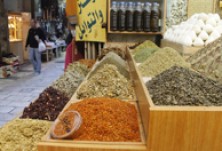Bus 75 from Bab al-‘Amud Bus Terminal in Sultan Suleiman Street makes a stop at the viewpoint. If driving, head east to the Mount of Olives through the al-Tour ascent to al-Muttal’h Hospital (Augusta Victoria), where the viewpoint is located a few meters north. Alternatively, take the Wadi al-Joz Street towards the Hebrew University Tunnel. Exit right before the tunnel and drive up to the viewpoint.
Mount of Olives Viewpoints
The Mount of Olives has a number of breathtaking viewpoints extending along it, most of which overlook the Old City and parts of Jerusalem outside the Wall to the west. These viewpoints have become major tourism spots for visitors and residents alike, who wish to observe the details of the Old City or take a general look at the region’s topography and the connections among its various geographical components. Among the viewpoints which deserve a stop is the Jerusalem Wilderness and Rift Valley viewpoint, to the east of Rabi’a al-‘Adawiyya Street, 50 meters north of al-Muttal’ Hospital entrance, just before the southeastern entrance to the Hebrew University, and close to the Egged Bus line stop.
Magic and Melancholy of the Scene
This viewpoint overlooks the Jordan Rift Valley, part of the Asian African Rift Valley. It is actually a link between two mountain peaks: al-Tur and Mount Scopus. It affords the opportunity to view the Jerusalem wilderness as well as the eastern municipalities of Jerusalem, such as al-‘Issawiyya, al-Zi’ayim, and al-‘Azariyya. It also provides a clear view of the Separation Wall, snaking around and boxing-in Arab villages in East Jerusalem, and reveals the extensive areas of settlements like Ma’aleh Adomim, Mishor Adomim and others.
Flora of the Mount of Olives
The change in the vegetation and flora of the Mount of Olives between its eastern and western slopes, due to the different rainfall levels, is noteworthy. The western slopes receive between 300 and 480 millimeters of rain annually, while the eastern slopes, seen from this Viewpoint, receive between 250 and 300 millimeters. Hence, olive trees grow extensively on the western slopes, giving the mountain its name, while desert plants abound on the eastern slopes. On a clear day, one can see some of the features of Amman and the city of Salt mountains. The viewpoint also provides spectacular sunrise scenes, while the Seven Arches viewpoint provides spectacular sunset views over the Old City.








